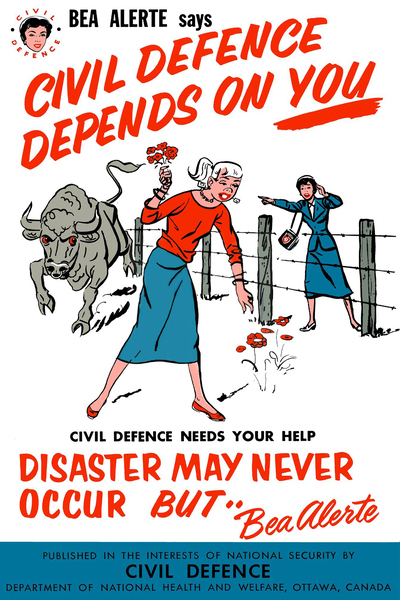Bea Alerte - The Post War Feminine Ideal
One moral trope common to early 1950’s Canada was feminine respectability. As Ryan (2012) points out in her analysis of “poster girls” in U.S. recruitment propaganda during World War II, visual cues such as dress, facial expression, hairstyle, and comportment conveyed a standardized and idealized feminine beauty that embodied normative archetypes.[38] A patriotic woman was expected to dress femininely but professionally - variations on the skirt suit, sensible heels, and perfectly coiffed hair; make-up chaste and minimal. Femininity should not cross the line into overt sexuality. With the expansion of industrial modernity in the 1950’s, the “modern” or progressive woman was distinguished from the respectable ideal by her depiction as sexually curious and therefore amoral.[39] In Canada during the Cold War, these stereotypes were reflected in public scandals describing “dangerous liaisons” between Canadian government officials and female spies, such as the story of Gerda Munsinger, an alleged KGB spy who reportedly engaged in elicit relationships with several cabinet ministers in the Diefenbaker government. Women had to navigate gendered nationalisms as they intersected with race, sexuality and class, and though not always strictly adhered to, standards of feminine respectability were repressive symbolically as well as structurally.
In this poster and in Figure 8, Bea Alerte conveys feminine respectability quite plainly. Dressed in a below-knee length skirt suit, buttoned shirt, hat and low heels, her outfit conforms to feminine norms of modesty, utility and tidiness. Her hair style and make up express wholesome professionalism; she is not at all sexualized. Even when running to perform some vital civil defence activity, Bea Alerte’s clothes remain in place. The same cannot be said for the blond-haired woman, Bea’s foil. She too wears a skirt, but her outfits are more casual - a boat neck blouse and jewelry. Her character suggests the loss of respectability, an image reinforced through her tattered and disarrayed clothing revealing undergarments and hints of exposed flesh. In terms of physical appearance, the same visual metaphors of feminine respectability are evident. Taking cues from 1950’s advertising campaigns in the Canadian women’s magazine Chatelaine, one can glean the normative physical beauty standards[40] to which Bea conforms: manicured brows, a small nose, clear complexion, thin lips and straight teeth. By contrast, the blonde-haired character is interpreted brashly; in one image she sports dark, undereye circles which could convey a lack of self-care or exhaustion. She also appears younger than Bea, leading to viewer to understand their relationship as maternal - an elder woman guiding a wayward child. These lessons in preparedness are part of the pedagogical dynamics of civil defence which instructed readiness training alongside gendered identity formation.
References
38 K.M Ryan, “Don’t miss your great opportunity: Patriotism and propaganda in Second World War recruitment,” Visual Studies 27, no.3 (2012): 75-86.
39 Llewelyn, 95.
40 Valerie Korinek, Roughing it in the Suburbs: Reading Chatelaine Magazine in the Fifties and Sixties (Toronto: University of Toronto Press, 2000), 141 and 142.
